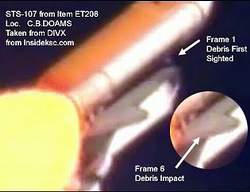Fri, Aug 01, 2003
CAIB Wants Pictures Can Help Troubleshoot Potential Debris
Issues
 NASA needs to see the
big picture when it comes to any future shuttle launches. That's
the recommendation of the Columbia Accident Investigation Board
(CAIB), which says high-resolution photos of the tank taken during
lift-off could help avoid another debris-related disaster. Columbia
disintegrated February 1st as it re-entered the atmosphere at the
end of a two-week long mission.
NASA needs to see the
big picture when it comes to any future shuttle launches. That's
the recommendation of the Columbia Accident Investigation Board
(CAIB), which says high-resolution photos of the tank taken during
lift-off could help avoid another debris-related disaster. Columbia
disintegrated February 1st as it re-entered the atmosphere at the
end of a two-week long mission.
The CAIB, charged with reporting to lawmakers and the American
people on how that could happen, says debris shed from the external
fuel tank probably punched a hole in the orbiter's left wing. That,
they theorize, allowed super-hot gases to melt critical parts of
the shuttle, eventually leading to its destruction. All seven
astronauts on board were killed.
"Imaging the space shuttle system during launch and ascent
provides necessary engineering data including the ability to
examine the space shuttle system for any unexpected debris or other
anomalies during ascent," the board said on its web site, www.caib.us.
All three remaining shuttles have cameras on board capable of
imaging the external fuel tank. The problem is, those pictures can
only be downloaded after the shuttle's mission is complete. One of
the board's recommendations, expected to be finalized by the end of
the month, will be for NASA to concoct a way to beam those pictures
back while the shuttle is still in orbit. That way, if there's any
sign of debris flaking off the external tank, engineers can figure
out what sort of damage it caused and how that damage should be
addressed.

The recommendations released Wednesday mark the fifth time the
CAIB has spoken out on its ideas for making shuttle flights safer.
The board also suggests the International Space Station be used as
an emergency repair facility should the space planes find
themselves in orbit, unable to land.
But that wouldn't have helped Columbia. As the first shuttle put
into service, it was simply too heavy to make the trip 240 miles
into space for a rendezvous with the ISS. In fact, the CAIB
has yet to say what, if anything, might have saved STS-107.
More News
From 2023 (YouTube Edition): "Ain’t Your Daddy’s Super Cub”—Don Wade Co-owned by Don and Ron Wade—the former of Don’s Dream Machines, a storied >[...]
Pilot-Rated Passenger Reported That The Pilot Did Not Adequately “Round Out” The Landing Flare And The Airplane Bounced And Yawed To The Right Analysis: The pilot state>[...]
Dead Reckoning Dead reckoning, as applied to flying, is the navigation of an airplane solely by means of computations based on airspeed, course, heading, wind direction, and speed,>[...]
Aero Linx: Lake Amphibian Club This website is created and sponsored by the Lake Amphibian Club, to help spread the word about these wonderful, versatile amphibians that can land j>[...]
“I am deeply honored to be sworn in as NASA administrator. NASA’s mission is as imperative and urgent as ever — to push the boundaries of human exploration, ignit>[...]
 Classic Aero-TV: In Praise of Alabamas Patriot Aircraft USA
Classic Aero-TV: In Praise of Alabamas Patriot Aircraft USA NTSB Final Report: Cirrus Design Corp SR22
NTSB Final Report: Cirrus Design Corp SR22 ANN's Daily Aero-Term (12.21.25): Dead Reckoning
ANN's Daily Aero-Term (12.21.25): Dead Reckoning ANN's Daily Aero-Linx (12.21.25)
ANN's Daily Aero-Linx (12.21.25) Aero-News: Quote of the Day (12.21.25)
Aero-News: Quote of the Day (12.21.25)




